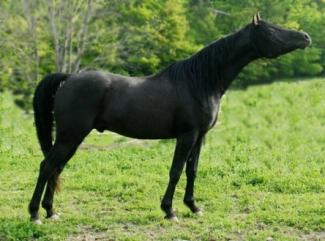Beginning Horse Color Genetics
Note: The original horse color was Bay Dun and all other colors are mutations of this wild-type color. However, for simplicity’s sake, we will leave the discussion of dun for a later time.
Pigment
All mammals produce two types of pigment, and horses are no exception. Eumelanin is black pigment and pheomelanin is red/yellow pigment. These two pigments work together to provide the basis of all horse colors. They are controlled by two genes, Extension (MCR1) and Agouti (ASIP).
Because these genes work together, they should always be considered as a unit rather than separately. By learning the foundation provided by these two genes, modifiers, dilutions, and white patterns can be added to create the entire palette of horse colors.
Extension (MCR1)
Extension in horses acts like a switch, controlling the production of eumelanin and pheomelanin. There are three alleles of this gene in horses E (wild-type) and two recessive alleles, e and ea. However, because e and ea function similarly, they are generally considered together as simply “e”. Horses that are EE or Ee can produce eumelanin (black pigment) horses that are ee will produce only pheomelanin and be chestnut or sorrel. There is significant variation in shade for chestnut that is completely unrelated to Agouti status.
Agouti (ASIP)
Agouti controls the distribution of pigment. Horses that carry a wild-type allele (AA or Aa) will be brown or bay. Black pigment is restricted to the mane, tail, and lower legs. Horses that carry only the recessive allele (aa) will be black, with black pigment distributed over the entire body.
Certain combinations of Extension and Agouti can also have an effect on shade. Horses with EE Aa genotype are strongly associated with the Seal or Brown coloration. There is still significant overlap between genotypes and phenotypes.
See the photo gallery for more examples of Bay/Brown, and Black.
| Gene | AA | Aa | aa |
|---|---|---|---|
| EE | Brown/Bay | Seal brown/Bay | Chestnut |
| Ee | Bay | Bay | Chestnut |
| ee | Black | Black | Chestnut |





